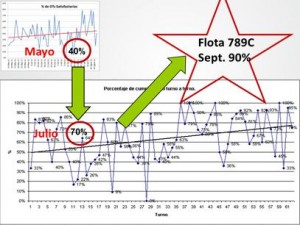Performance metrics should point us to precisely what we need to improve currently in our maintenance process. That is, they should trigger a control action. Subsequently they should confirm and measure the extent to which the control action had the desired effect.
Often, performance metrics do not indicate what management action must be taken to achieve an organizational objective. Cascading metrics (high to low or “lagging” to “leading”) will solve this problem and will, therefore, drive the continuous improvement process.
- High level (organizational) KPIs, provide, at various levels of granularity, such measures as:
- MTTF and MTTR,
- Costs, and
- Yield
- Low level KPI’s in maintenance should measure such indicators as:
- RCM knowledge added,
- The number of links between RCM knowledge and work orders,
- The number of analyses performed and recommendations issued,
- CBM performance measurement such as the standard deviation in remaining useful life estimation,
- CBM hit and miss ratios (detection confidence).
Managers must recognize the important differences between high and low level KPI’s. Basically, that:
- Employees have no direct influence on high level KPIs. Thus, throwing these performance results back at them will elicit little interest or engagement.
- Low level KPIs, by definition, respond directly to team performance. They relate to day-to-day activities and actions as they should be specified in personnel job descriptions.
Here is the key point: It is management’s job to set low level objectives (i.e. KPI values) that:
- Employees can influence by the way they perform their duties, and that
- Support the high level organizational targets.
Managers exercise creativity in setting low level objectives. They must then build their skills in understanding the lags and complexities between the achievement of low level KPIs and the eventual resulting high level (organizational) metrics.
© 2011 – 2012, Murray Wiseman. All rights reserved.

